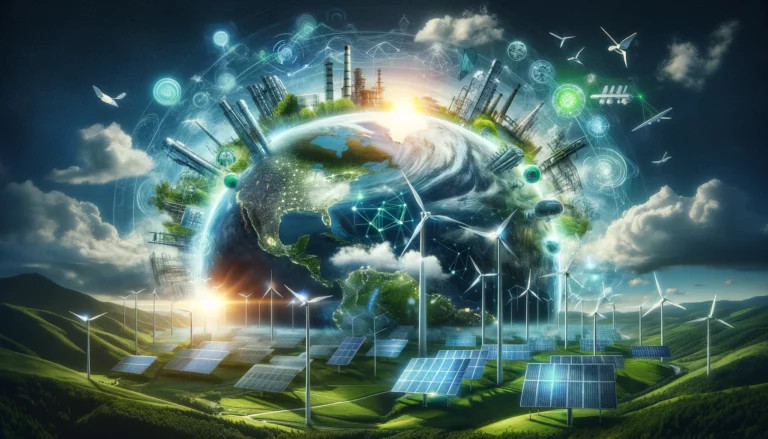Turning the Tide

Section 1: Understanding Bioenergy
Bioenergy is at the forefront of renewable energy solutions, offering a sustainable alternative to fossil fuels by harnessing materials derived from biological sources. As we explore the realm of bioenergy, it’s essential to grasp its types, production processes, and the dual-edged sword of its benefits and challenges.
Types of Bioenergy
Bioenergy comes in various forms, each with its unique production process and application:
- Biomass: This includes organic materials such as wood, agricultural crops, and waste residues. Biomass can be directly burned for heat or converted into biofuels.
- Biofuels: Liquid fuels like ethanol and biodiesel are produced from fermenting sugar or vegetable oils. These biofuels can replace gasoline and diesel for transportation.
- Biogas: Produced through the anaerobic digestion of organic matter by bacteria, biogas is a mixture of methane and carbon dioxide. It can be used for heating, electricity generation, and as a vehicle fuel.
Production of Bioenergy
The production of bioenergy begins with the collection of organic materials. These materials can be agricultural residues, like straw and manure, forestry residues, or even specially grown energy crops. Through processes such as combustion, gasification, anaerobic digestion, and fermentation, these raw materials are transformed into usable energy in the form of heat, electricity, or fuel.
Benefits of Bioenergy
Bioenergy presents numerous advantages:
- Renewability: Unlike fossil fuels, bioenergy sources can be replenished, making them a sustainable energy option.
- Carbon Neutrality: When biomass grows, it absorbs CO2 from the atmosphere, which can offset the carbon released during bioenergy production, leading to a potentially carbon-neutral cycle.
- Waste Reduction: Utilizing organic waste for energy can significantly reduce landfill use and methane emissions from decomposition.
Challenges of Bioenergy
Despite its benefits, bioenergy’s sustainability is a topic of debate, primarily due to:
- Land Use: The cultivation of energy crops might compete with food production or lead to deforestation, affecting biodiversity and food security.
- Resource Intensity: Growing biomass requires significant water and fertilizer, which can strain local resources and impact the environment.
- Energy Balance: The energy output from bioenergy must be significantly higher than the energy invested in growing, harvesting, and processing biomass to be considered sustainable.
As we delve deeper into the nuances of bioenergy, it’s clear that while it offers a promising path towards renewable energy, its implementation requires careful consideration of environmental and social impacts. The balance between leveraging bioenergy for its renewable benefits while mitigating its challenges is crucial for its role in a sustainable energy future.
Section 2: The Science of Carbon Capture and Storage (CCS)
Carbon Capture and Storage (CCS) is a pivotal technology in the fight against climate change, offering a method to significantly reduce CO2 emissions from industrial processes and fossil fuel combustion. Understanding CCS is crucial for grasping the full potential of BECCS. This section delves into the technologies and methods used in CCS, its significance, and the challenges it faces.
What is CCS?
CCS encompasses a suite of technologies aimed at capturing carbon dioxide emissions from sources like power plants and industrial facilities, transporting it to a storage site, and depositing it underground in geological formations where it cannot enter the atmosphere. This process effectively removes CO2 from the emission stream, preventing its contribution to global warming.
Technologies and Methods Used in CCS
- Capture: There are three primary methods for capturing CO2: post-combustion (removing CO2 from flue gases), pre-combustion (converting fuel into a mixture of hydrogen and CO2 before combustion), and oxy-fuel combustion (burning fuel in pure oxygen to produce a stream of CO2 and water vapor for easier capture).
- Transport: Once captured, CO2 is compressed to a liquid-like state and transported, usually via pipelines, to a storage site.
- Storage: The final step involves injecting CO2 into geological formations deep underground, such as depleted oil and gas fields or deep saline aquifer formations, where it is securely and permanently stored.
Significance of CCS in Mitigating Climate Change
The importance of CCS lies in its ability to capture up to 90% of CO2 emissions from the combustion of fossil fuels and industrial processes, making it a critical component in efforts to reduce greenhouse gas levels. By allowing for the continued use of fossil fuels in a cleaner manner and capturing industrial emissions, CCS provides a pathway to achieving emission reduction targets and a transition to a low-carbon economy.
Challenges and Limitations
Despite its potential, CCS faces several challenges:
- Cost: High capital and operational costs are significant barriers to widespread adoption. Developing and deploying CCS technology requires substantial investment.
- Energy Requirements: The process of capturing and storing CO2 is energy-intensive, potentially reducing the overall efficiency of power plants equipped with CCS.
- Storage Concerns: There are uncertainties regarding the long-term integrity of storage sites, including the risk of leakage and the need for continuous monitoring.
- Public Perception: The concept of storing CO2 underground has raised concerns among communities and stakeholders, necessitating clear communication and engagement strategies.
In conclusion, while CCS presents a promising avenue for significantly reducing CO2 emissions, realizing its full potential will require overcoming economic, technical, and societal hurdles. As we advance into integrating CCS with bioenergy, the combined approach of BECCS opens new avenues for achieving negative emissions, a crucial step toward mitigating climate change.
Having explored the intricacies of CCS, we’re set to delve into how integrating bioenergy with this technology leads to BECCS, offering a deeper understanding of its operations, impacts, and the challenges it faces.
Section 3: Integrating Bioenergy with CCS: BECCS Explained
The integration of Bioenergy with Carbon Capture and Storage (BECCS) represents a groundbreaking approach in our arsenal against climate change, merging the renewable energy production of bioenergy with the greenhouse gas mitigation potential of CCS. This section delves into the workings of BECCS, its potential for creating negative emissions, current projects around the globe, and its broader economic and environmental impacts.
How BECCS Works
BECCS involves the process of generating energy from biomass, such as wood, crops, or waste, and capturing the carbon dioxide produced during this energy generation. Instead of releasing this CO2 into the atmosphere, it is transported and stored underground, effectively removing it from the carbon cycle. This process not only generates renewable energy but also results in a net reduction of CO2 levels in the atmosphere, hence the term “negative emissions.”
Potential of BECCS
The most significant potential of BECCS lies in its ability to achieve negative carbon emissions. This means that BECCS can help to actively remove more CO2 from the atmosphere than it emits, a critical capability in our efforts to limit global warming to below 2°C, as outlined in the Paris Agreement. By leveraging biomass, which is part of the natural carbon cycle, BECCS offers a sustainable pathway to decarbonize energy production and industrial processes.
Case Studies and Current Projects
Globally, several BECCS projects highlight the technology’s feasibility and potential:
- Illinois Industrial CCS Project: Located in the United States, this project captures CO2 from ethanol production and stores it underground, showcasing BECCS in an industrial setting.
- Vattenfall’s BECCS Pilot at Stockholm Biochar Project: In Sweden, this pilot project produces biochar from garden and park waste, capturing CO2 in the process and contributing to urban greening efforts.
- Drax Power Station: In the UK, Drax has converted some of its units to burn biomass instead of coal and is exploring CCS technology to become carbon negative.
Economic and Environmental Impact
Economically, BECCS offers the dual benefits of renewable energy production and carbon sequestration, which can contribute to job creation, energy security, and the potential generation of carbon credits. Environmentally, BECCS can play a crucial role in reducing atmospheric CO2 levels, but its sustainability is contingent upon responsible biomass sourcing to avoid negative impacts on biodiversity, land use, and water resources.
Challenges Facing BECCS
Despite its potential, BECCS is not without challenges:
- Sustainability of Biomass: Ensuring that biomass is sourced in a manner that does not harm ecosystems or food security is paramount.
- Scale and Infrastructure: Scaling up BECCS to a level where it can significantly impact global CO2 levels requires substantial investment in infrastructure and technology.
- Economic Viability: High costs associated with CCS technology and biomass production need to be addressed to make BECCS economically competitive.
- Policy and Regulation: Effective policies and incentives are necessary to support the development and deployment of BECCS technologies.
In conclusion, BECCS holds a unique position in climate mitigation strategies, offering a path to not only reduce emissions but to actively remove CO2 from the atmosphere. As we move forward, the focus must be on addressing the technological, economic, and ethical challenges to unlock the full potential of BECCS in our transition to a sustainable and low-carbon future.
Section 4: The Debate Around BECCS
The conversation surrounding Bioenergy with Carbon Capture and Storage (BECCS) is multifaceted, involving a spectrum of perspectives from enthusiastic support to critical opposition. This section will navigate through the potential benefits, the environmental and ethical concerns, and the varied stances of different stakeholders involved in the discourse on BECCS.
Potential Benefits of BECCS
Proponents of BECCS highlight several key benefits that underscore its importance in climate change mitigation efforts:
- Negative Emissions: BECCS stands out for its capacity to generate negative carbon emissions, offering a promising solution to not only halt but reverse the accumulation of CO2 in the atmosphere.
- Versatility: BECCS can be applied across various sectors, including power generation, industrial processes, and even in the creation of sustainable biofuels, providing a versatile tool in reducing global greenhouse gas emissions.
- Economic Development: The development and implementation of BECCS technology have the potential to spur economic growth through job creation in renewable energy sectors and carbon capture technologies.
Environmental and Ethical Concerns
Despite the potential benefits, BECCS faces significant environmental and ethical concerns:
- Land Use and Biodiversity: The large-scale cultivation of biomass can lead to deforestation, loss of biodiversity, and competition with food production, raising questions about the sustainability and ethical implications of diverting land resources.
- Water Use: Biomass production is often water-intensive, posing challenges in water-scarce regions and potentially exacerbating water stress.
- Carbon Storage Safety: The long-term safety and viability of carbon storage remain uncertain, with concerns about possible leaks and the environmental impact of stored CO2.
- Social and Economic Equity: There are also concerns about the social and economic impacts of BECCS projects, particularly on local communities and indigenous populations, regarding land rights and access to resources.
Stakeholder Perspectives
The debate around BECCS involves a wide range of stakeholders, each with their unique concerns and priorities:
- Scientists and Researchers: Focus on assessing the technical feasibility, scalability, and environmental impacts of BECCS, contributing to an ongoing dialogue about its role in climate mitigation strategies.
- Policymakers: Are tasked with balancing the potential of BECCS against its costs and risks, considering regulations and incentives that can support sustainable implementation.
- Environmental Advocates: Often express concerns about the ecological footprint of BECCS, advocating for strict sustainability criteria and the protection of natural ecosystems.
- Industry Leaders: While some see BECCS as a critical technology for achieving emissions reductions targets, others weigh the economic implications and the challenges of integrating BECCS into existing energy systems.
Navigating the Debate
The discourse around BECCS underscores the complexity of addressing climate change with a single technological solution. It highlights the need for a holistic approach that considers environmental sustainability, economic viability, and social equity. As the conversation evolves, it is crucial that the development and deployment of BECCS are guided by rigorous scientific research, transparent policy-making, and inclusive dialogue among all stakeholders.
Conclusion
Bioenergy with Carbon Capture and Storage (BECCS) presents a compelling yet contentious solution in the global effort to combat climate change. With its potential for negative emissions, BECCS could play a pivotal role in achieving net-zero emissions goals. However, its successful implementation hinges on overcoming significant environmental, technical, and ethical challenges.
As we stand at the crossroads of climate action, the future of BECCS will depend on our ability to navigate these complexities thoughtfully and sustainably. This requires a commitment to innovation, collaboration, and a balanced consideration of the diverse impacts of BECCS. By fostering an environment where research, policy, and community engagement converge, we can ensure that BECCS contributes positively to our shared goal of a sustainable and resilient future.
The journey toward a greener future is a collective one, and technologies like BECCS underscore the interconnected nature of our climate solutions. Embracing the challenge, informed by science and guided by ethical considerations, we can move forward together in shaping a world that thrives on sustainable energy solutions.




